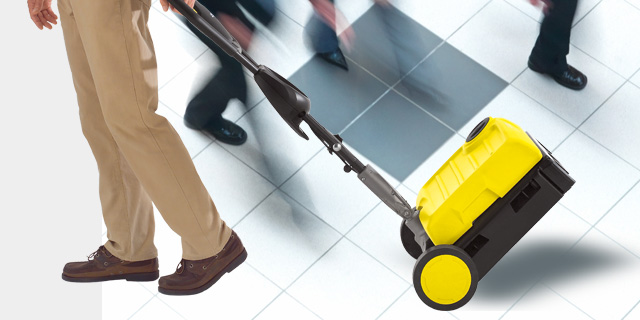Cylindrical or Rotary? That Is the Question
What is Cylindrical Brush Technology?
Cleaning professionals in Europe and other parts of the world, often implement new cleaning technologies, products, and equipment years before they became popular in the United States. For instance, while microfiber cleaning cloths and mops have been used in Europe for more than 20 years, it has been only in the past few years that they have become commonplace in this country.
The same applies to cylindrical brush technology. Cylindrical floor machines—that have roller brushes, as compared to traditional rotary buffers with a single rotary disk—have been used in Europe for about 20 years.
In Europe, many buildings are centuries old, and because of this their floors are often uneven or sloped. Additionally, many of the floors in these old buildings are made of stone, marble, and similar materials rather than the smooth-surface tile and linoleum that are common in this country. While rotary machines do an excellent job on smooth floors, in truth they are much less effective on grouted, architectural, and other uneven floor surfaces. Cylindrical brush technology was originally developed to specifically address this problem.
Thanks in large part to Tornado Industries, who helped pioneer scrubbers with cylindrical brush technology in North America, interest in cylindrical floor machines has continued to grow and has a very strong following today in the United States.
The following evaluation should help distributors and cleaning professionals better understand how cylindrical and rotary systems differ and which might best fit their needs. It may also answer a few questions and help clarify some of the features and benefits cylindrical brush technology offers.
Traditional rotary buffers use pads and rotate or spin horizontally, from side to side, at approximately 175 to 300 revolutions per minute (rpm). Cylindrical machines have brushes and are multidirectional—they can be maneuvered side to side, forward and backward—at 400 rpm to 1,400 rpm.
Many floor care experts now recommend cylindrical brush units as the unit of choice for common floor care tasks, such as polishing, scrubbing, and stripping, appreciative that cylindrical machines offer greater contact pressure and higher rpm than rotary units, resulting in enhanced cleaning results.
The pads on rotary machines have a tendency to “throw” cleaning solution on baseboards and walls. Additionally, because they are round, it is hard to line them up against the wall for edge cleaning. Because of this, some floor care technicians find it better to do “edge work” by hand instead of with the machine.
Cylindrical machines have counter-rotating brushes that rotate inward, so splashing solution against walls and baseboards is not a problem. In addition, because the machines have a square base, they can line up directly against baseboards to facilitate edge and corner cleaning.
With a rotary machine, the cleaning solution may be unevenly distributed because of the pads’ horizontal rotation. To rectify this, floor care technicians need to make several passes over the same floor area to evenly apply the solution. With a cylindrical machine, a film of cleaning solution forms between the two parallel rollers. This allows the machine to better penetrate the floor with detergent, apply it more evenly to the floor, and improve productivity.
When working on structured floors, such as rubber-studded floors, grouted, and uneven or stone floors, cylindrical technology produces superior results, compared to rotary machines. This is because cylindrical brushes on these units can penetrate the highs and lows of the floor much easier than a rotary or disc machine can.
Overall, cylindrical machines are more versatile than traditional rotary machines. And, because they apply cleaning solution more effectively with higher rpm and contact pressure, productivity is often much higher.

